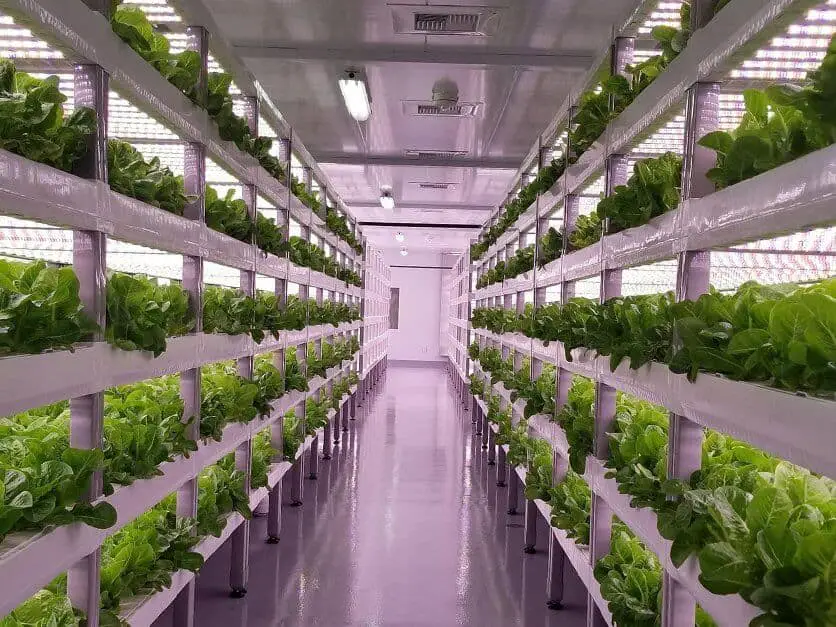Vertical farming is going to be the way of the future. Making use of vertical space and growing plants in controlled and optimized conditions means that farms no longer need to take up acres and acres of land to make a living. But questions abound about how people are growing fruits and vegetables in vertical farms and what all is required. Soil is an essential part of traditional farming, but you’re probably wondering if it is necessary for a vertical farm.
Does vertical farming use soil? No, vertical farming does not use soil. If the farm uses hydroponic or aquaponic systems, then it will likely use a soilless growing medium. If it uses an aeroponic system, then it will not even use a growing medium. That being said, you’ll never find soil used at a large scale vertical farm.
So, what are these growing mediums used in hydroponic and aquaponic systems, and how does a plant grow in an aeroponic system? In this article, we will answer these questions and more, so keep reading!
Growing Mediums Used in Vertical Farming
Vertical farming is a method of farming that makes use of vertical, indoor space to grow large quantities of fruits and vegetables. It typically uses hydroponic, aeroponic, or aquaponic growing practices to grow as much food as possible in as little space as possible.
Growing Medium for Hydroponic Vertical Farming
Not all hydroponic setups require a growing medium for all plants, but most plants benefit from supported roots, and many hydroponic methods require a growth medium.
Here are some of the growing mediums used for hydroponic farming:
- Rockwool: Rockwool is a synthetic material that has long been used by hydroponic farmers. It is inexpensive and easy to access, but many eco-minded farmers are switching to more natural and compostable options.
- Coconut coir: This natural material is what used to end up in the garbage pile after a coconut was processed. It is becoming a popular growing medium among hydroponic farmers because it is all-natural, doesn’t attract insects, and is closer to pH neutral than other options.
- Perlite: Perlite is a processed form of volcanic glass. It is lightweight, reusable, and pH neutral. It is usually used mixed into other growing mediums, but it can make an excellent stand-alone medium as well.
- Vermiculite: This is a processed mineral similar to perlite in that it is lightweight, but it does a better job of retaining moisture than perlite.
- Clay pebbles: Clay pebbles meant for hydroponic growing are lightweight, porous, and reusable, making them a favorite for some types of plants.
There are many other possible growing mediums for hydroponics, including many “homebrew” methods. This list includes the most popular methods used for widescale growing. The growing medium you choose will depend on the hydroponic system you have in place. A wicking system will require a different medium than a deep water culture system.
Growing Medium for Aquaponic Vertical Farming
Aquaponics is similar to hydroponics. The main difference is where the nutrients come from. In hydroponics, a nutrient solution is added to the water. In an aquaponic system, the nutrients come from fish waste. Fish waste is processed by beneficial bacteria that live by the roots of the plants, and it becomes plant food.
Growing mediums for vertical aquaponic farms need to meet all the same requirements for hydroponic growing medium and provide enough surface area for the beneficial bacteria to live and not break down easily when sitting in water.
Here are some of the commonly used growing mediums for aquaponic systems:
- Lava rocks: Lava rocks are exactly what you might think they are: the rocks that form when lava cools. They are very porous, so there is plenty of room for bacteria.
- Clay pebbles: These are the same clay pebbles you might use in a typical hydroponic setup. They provide enough surface area but are more prone to floating until they get acclimated to the water.
- Rocks: Pea gravel, river rocks, and expanded shale are all different types of rocks that can be used for aquaponics.
- Rockwool: Rockwool does well in an aquaponic system because it doesn’t breakdown when exposed to water.
Growing Medium for Aeroponic Vertical Farming
In aeroponic systems, there is no growing medium at all! The seeds are started on a mesh holder, and the plant is sometimes supported by foam or a collar. Plants can also be transplanted from rockwool into the aeroponic system, but it isn’t necessary.
The roots of the plant are misted with a nutrient solution and do not have access to standing water as they would in a hydroponic system.
Plants grown using aeroponic methods typically benefit from the increased access to oxygen since there is no growing medium to block access. However, if done improperly, the plant could suffer from a lack of stability.
As you can see, none of the methods used to grow plants in a vertical farming environment.
Why Don’t Vertical Farmers Use Soil?
Although plants seem to like soil when growing outdoors, there are some real disadvantages to growing plants in soil.
- Soil is heavy. Consider how much growing medium would be required for a vertical farm. This could put a lot of stress on a building and require costly upgrades to the space.
- Diseases and pests. Even treated soil could contain harmful diseases and pests, and once they’re in the building, it could be challenging to get rid of them if all the plants are grown in soil.
- Difficult to optimize nutrients. Soil eventually gets depleted of nutrients and has to have fertilizer added to it. This isn’t all that difficult of a process, but just dumping some nutrients into your hydroponic system is going to be infinitely easier. It is also easier to optimize nutrient levels at different stages of growth.
- Aeration may not be great. In a hydroponic system, roots have easy access to oxygen. When growing in soil, this is far from the case.
- Soil isn’t compatible with hydroponic growing. Hydroponic growing is recognized as one of the best methods of farming indoors, and you can’t use soil in a hydroponic system. It breaks down too quickly when exposed to water and may contain harmful microbes.
Does Soilless Growing Work for Vertical Farming?
It really does work! While it might take some time to learn the ins and outs growing methods that don’t involve soil, reports suggest that plants grow faster, healthier, and yield more in hydroponic environments.
Soilless growing in a controlled environment like that of a vertical farm works well because:
- The roots of the plants have more access to oxygen.
- The nutrients delivered to the plant are optimized.
- Light conditions are optimized.
- Temperature conditions can be optimized.
- Growth is not hindered by weather.
Growing Without Soil: The Way of the Future
So, soilless growing not only works well, but it also has better outcomes than soil-based farming.
Vertical farming methods work so well that one farm can produce 100,000 pounds of food a year on just one-tenth of an acre and employs those with disabilities who would otherwise have a hard time finding employment. It would take ten acres of land to produce the same amount of food. You can check out their operation on YouTube by clicking here.
So, anyone with a tenth of an acre and some start-up funds can produce thousands of pounds of food each year, and they can do it year-round without using soil. Which leaves only one question: why aren’t we?



Subscribe To Our Newsletter
Join our mailing list to receive news and updates. Don't worry. We will not smap you ;)
You have Successfully Subscribed!